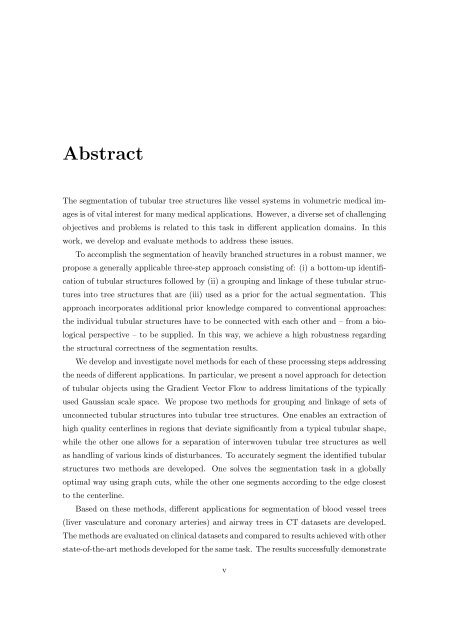Segmentation of 3D Tubular Tree Structures in Medical Images ...
Segmentation of 3D Tubular Tree Structures in Medical Images ...
Segmentation of 3D Tubular Tree Structures in Medical Images ...
Create successful ePaper yourself
Turn your PDF publications into a flip-book with our unique Google optimized e-Paper software.
Abstract<br />
The segmentation <strong>of</strong> tubular tree structures like vessel systems <strong>in</strong> volumetric medical images<br />
is <strong>of</strong> vital <strong>in</strong>terest for many medical applications. However, a diverse set <strong>of</strong> challeng<strong>in</strong>g<br />
objectives and problems is related to this task <strong>in</strong> different application doma<strong>in</strong>s. In this<br />
work, we develop and evaluate methods to address these issues.<br />
To accomplish the segmentation <strong>of</strong> heavily branched structures <strong>in</strong> a robust manner, we<br />
propose a generally applicable three-step approach consist<strong>in</strong>g <strong>of</strong>: (i) a bottom-up identification<br />
<strong>of</strong> tubular structures followed by (ii) a group<strong>in</strong>g and l<strong>in</strong>kage <strong>of</strong> these tubular structures<br />
<strong>in</strong>to tree structures that are (iii) used as a prior for the actual segmentation. This<br />
approach <strong>in</strong>corporates additional prior knowledge compared to conventional approaches:<br />
the <strong>in</strong>dividual tubular structures have to be connected with each other and – from a biological<br />
perspective – to be supplied. In this way, we achieve a high robustness regard<strong>in</strong>g<br />
the structural correctness <strong>of</strong> the segmentation results.<br />
We develop and <strong>in</strong>vestigate novel methods for each <strong>of</strong> these process<strong>in</strong>g steps address<strong>in</strong>g<br />
the needs <strong>of</strong> different applications. In particular, we present a novel approach for detection<br />
<strong>of</strong> tubular objects us<strong>in</strong>g the Gradient Vector Flow to address limitations <strong>of</strong> the typically<br />
used Gaussian scale space. We propose two methods for group<strong>in</strong>g and l<strong>in</strong>kage <strong>of</strong> sets <strong>of</strong><br />
unconnected tubular structures <strong>in</strong>to tubular tree structures. One enables an extraction <strong>of</strong><br />
high quality centerl<strong>in</strong>es <strong>in</strong> regions that deviate significantly from a typical tubular shape,<br />
while the other one allows for a separation <strong>of</strong> <strong>in</strong>terwoven tubular tree structures as well<br />
as handl<strong>in</strong>g <strong>of</strong> various k<strong>in</strong>ds <strong>of</strong> disturbances. To accurately segment the identified tubular<br />
structures two methods are developed. One solves the segmentation task <strong>in</strong> a globally<br />
optimal way us<strong>in</strong>g graph cuts, while the other one segments accord<strong>in</strong>g to the edge closest<br />
to the centerl<strong>in</strong>e.<br />
Based on these methods, different applications for segmentation <strong>of</strong> blood vessel trees<br />
(liver vasculature and coronary arteries) and airway trees <strong>in</strong> CT datasets are developed.<br />
The methods are evaluated on cl<strong>in</strong>ical datasets and compared to results achieved with other<br />
state-<strong>of</strong>-the-art methods developed for the same task. The results successfully demonstrate<br />
v















